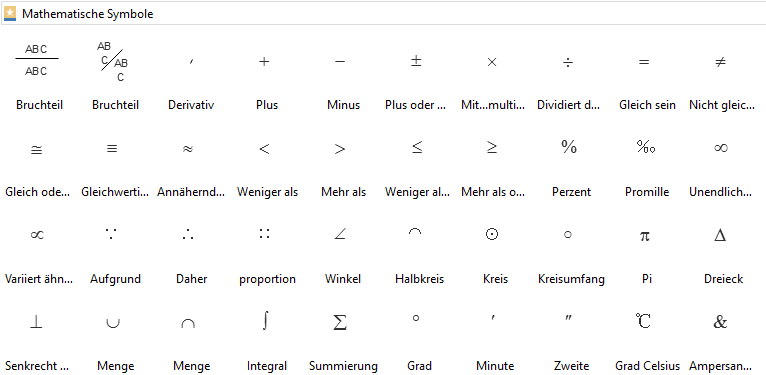Decoding the magic of mathematics: A journey through mathematical signs and symbols
Published

Mathematics is a discipline of science that deals with the study of numbers, structures, patterns and ratios. It is one of the oldest and most fundamental sciences and plays a crucial role in almost all other areas of knowledge and application, including science, engineering, economics, computer science and many others.
Mathematics covers various areas, including:
- Arithmetic: This area deals with basic mathematical operations such as addition, subtraction, multiplication and division. It is the basis for all further mathematical studies.
- Algebra: Algebra deals with the handling of unknowns and variables in equations and inequalities. It enables the solution of complex mathematical problems. (Not to be confused with Lineare Algebra )
- Geometry: Geometry examines the properties of shapes, sizes and distances. It deals with figures such as lines, circles, triangles and much more.
- Analysis Analysis (also known as calculus) is an area of mathematics that deals with limits, derivatives and integrals. It is fundamental to the understanding of change and continuity.
- Statistics Statistics deals with the collection, analysis and interpretation of data. It plays an important role in empirical research and decision-making processes.
- Probability theory: This area of mathematics examines random events and their probabilities. It is used in statistics, financial mathematics and many other areas.
- Discrete mathematics This area deals with discrete structures, such as graph theory and number theory. It is used in computer science and cryptography.
Mathematics is not only a theoretical discipline, but also has practical applications in various areas of everyday life. It is a powerful tool for solving problems and modeling phenomena in the real world.
Mathematics characters
There are a large number of mathematical signs and symbols used in mathematics. It is difficult to determine an exact number, as new symbols can be developed and some symbols may have different meanings in different areas of mathematics. However, here are some of the most common mathematical symbols:
- Numbers: Numbers such as 0, 1, 2, 3, ... are basic mathematical symbols.
- Basic arithmetic symbols: Symbols such as + (addition), - (subtraction), * (multiplication) and / (division) are used in arithmetic operations.
- Greek letters: Greek letters such as α (alpha), β (beta), γ (gamma) and δ (delta) are often used as variables or constants in mathematics.
- Algebraic symbols: Symbols such as x, y, z are often used as variables in algebraic equations.
- Relational symbols: Symbols such as = (equality), ≠ (inequality), < (less than), > (greater than), ≤ (less than or equal to) and ≥ (greater than or equal to) are used to express relationships between numbers or expressions.
- Operators: Symbols such as ∑ (sum), ∫ (integral), ∆ (difference) and √ (square root) are used to represent mathematical operations.
- Set symbols: Symbols such as ∈ (element of), ∪ (union), ∩ (average) and ⊆ (subset) are used in set theory.
- Trigonometric symbols: Symbols such as sin (sine), cos (cosine) and tan (tangent) are used in trigonometry.
- Logarithmic symbols: Symbols such as log (logarithm) and ln (natural logarithm) are used in analysis.
- Special mathematical symbols: There are also many special symbols for mathematical concepts such as ∞ (infinity), π (Pi), e (Euler's number) and i (imaginary unit).
- Integration sign (∫): Stands for integration, the reversal of the derivative, in calculus.
- Square root (√): Displays the positive square root of a number.
- Cubic root (∛): Indicates the positive cube root of a number.
- Element-of symbol (∈): Used to indicate that an element belongs to a specific set.
- Union sign (∪): Represents the union of sets, i.e., all elements that are contained in at least one of the sets.
- Average sign (∩): Indicates the average of sets, i.e. the elements contained in all sets.
- Subset symbol (⊆): Used to indicate that a set is a subset of another set.
- Equals sign (=): Indicates that two expressions or values are equal.
- Inequality sign (≠): Indicates that two expressions or values are not equal.
- Less-than sign (<) and greater-than sign (>): Indicates that a value is smaller or larger than another value.
- Less than or equal to sign (≤) and greater than or equal to sign (≥): Indicate that a value is less than or equal to or greater than or equal to another value.

- Sine (sin), cosine (cos) and tangent (tan): Trigonometric functions used in geometry and trigonometry.
- Logarithm (log) and natural logarithm (ln): Mathematical functions for calculating exponents and powers.
- Infinity (∞): A mathematical concept representing an infinite quantity or set.
- Pi (π): A mathematical constant that represents the ratio of the circumference of a circle to its diameter.
- Euler's number (e): An important mathematical constant that occurs in calculus and the exponential function.
- Imaginary unit (i): A mathematical unit used in complex number theory to represent complex numbers.
This list is not exhaustive as there are many more mathematical symbols and concepts. Mathematics is an extremely diverse and broad discipline, and the use of symbols can vary depending on the mathematical field.








